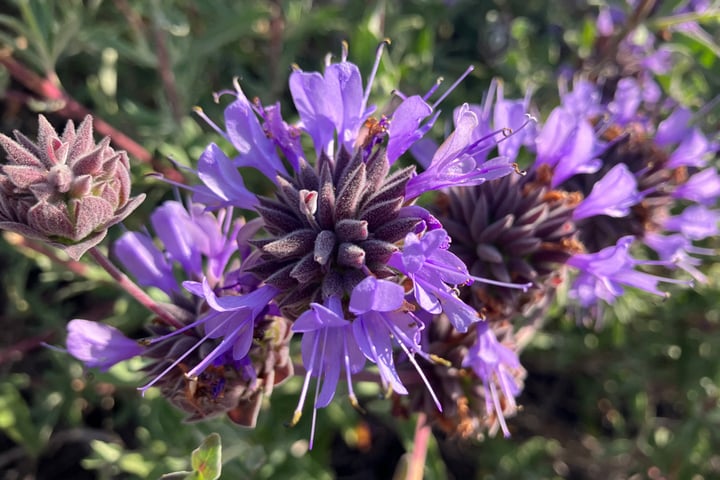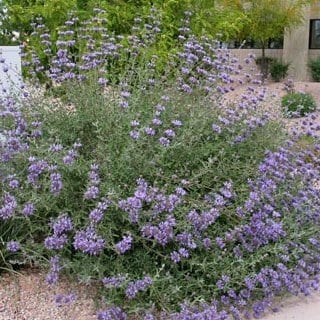Cleveland sage is an evergreen shrub with whorls of purple flowers that pollinators love. As a native to coastal California, it prefers a Mediterranean climate, but it can be grown in the hot desert, too. Here’s everything you need to know about growing this lovely plant in the desert southwest in this complete care guide.

Cleveland sage (Salvia clevelandii) is a medium size, evergreen shrub with aromatic, fuzzy gray-green leaves. Spring through summer, flower stalks are covered with whorls of tubular flowers that range from lavender to blue or purple. The overall effect is wispy making it look more like a perennial than a shrub.
Its nectar-rich flowers are highly attractive to hummingbirds, butterflies, bees, moths, and other pollinators.
It has a strong herbal aroma which most people enjoy, but it seems to repel deer, rabbits, and javelinas.
Why I Like This Plant
- Aromatic evergreen leaves
- Lavender, purple, or blue flowers
- Low maintenance
- No thorns, low litter, non-toxic
- Attracts hummingbirds, butterflies, bees
Things to Watch Out For
At first glance, you may assume this is a desert plant, since it’s native to California and Mexico. But it’s not from their interior deserts, it’s native to coastal southern California and northern Baja, Mexico. This region has a Mediterranean-type climate, which is cooler and less intensely sunny than the desert.
I’ve found this perennial shrub a little temperamental in the desert. Finding the perfect spot in desert gardens can be a challenge. In its native habitat, it grows in full sun, but that does not mean Arizona’s death star sun. It doesn’t thrive in the hottest areas and needs some shade in the summer.
It’s considered evergreen, but can lose its leaves in the summer in response to drought or cold. The more sun it receives, the more water it needs, but too much water can cause root rot.
Watering guidelines from trusted sources vary greatly — from once a month in the summer to every 4 to 6 days. So figuring out what works for this plant in your yard might take some trial and error.
The leaves are highly aromatic and the scent can waft several feet from the plant. This is great if you love its aroma, but not everyone does.

And finally, be aware that it’s a short-lived plant.
Optimal Growing Conditions
If you’re thinking of adding Cleveland sage to your garden, you need to find a suitable place that will keep your plant healthy and looking good… while minimizing maintenance for you.
Here are the key factors to keep in mind.
Temperature
Cleveland sage should be grown in USDA Hardiness Zones 9 to 11. It is extremely cold-hardy down to around 10°F. However, it suffers from heat stress once the temperature hits 115℉, and struggles in hot places like Phoenix. It should not be planted in the hottest spot in your yard.
Sun Exposure
Cleveland sage does best in full sun or part shade. It will struggle with either reflected sun or full shade. Ideally, it should be grown where it gets some relief from summer sun, especially in the afternoon.
If you plant one in full sun, it’s imperative that it gets adequate water during the summer or it will fry.
Size and Growth Rate
Cleveland sage is considered a moderate-to-faster grower that typically stays around 4 feet tall by 4 feet wide.

Soil
Cleveland sage is not particular about soil, provided it’s well-draining. It will grow in sand, loam, clay, gravel, or rocky desert soil.
Pests & Diseases
Cleveland sage is generally not bothered by pests or diseases. You may occasionally see spittlebugs on the stems, which appear as small spots of white foam. They won’t harm your plant, so you can let them be. They can easily be removed by gently wipe them with your finger or hosing them off.
Other Location Considerations
Because Cleveland sage has no thorns, and is non-toxic and low litter, it’s a plant you can feel comfortable placing near a pool, sidewalk, or anywhere it might come in contact with pets and people.
Cleveland Sage:
The Essentials
| Common Names | Cleveland sage |
| Scientific Name | Salvia clevelandii |
| Origin | California, Baja Mexico |
| Plant Type | Evergreen shrub |
| USDA Zones | Zones 9 – 11 |
| Cold Hardy | To 10℉ |
| Flower Color | Lavender |
| Flower Season | Spring, summer |
| Mature Size | 4’ high x 4’ wide |
| Growth Rate | Moderate to fast |
| Sun Tolerance | Full, part sun |
| Water Needs | Low |
| Pests & Diseases | Root rot, spittlebug |
| Garden Friendly | No thorns, low litter, non-toxic |
| Wildlife | Attracts birds, bees, hummingbirds |
How to Plant
The rule of thumb when planting any shrub in the desert is to dig a hole three times as wide as the root ball but no deeper. Amending the soil is not recommended. Counterintuitively, backfilling with the same native soil you just dug up helps your plant develop a stronger root system.
However, this plant prefers to be topped with organic mulch rather than gravel. (Learn more about mulching in the desert here.)
When to Plant
The best time to plant Cleveland sage is in the fall. This gives your shrub three seasons to grow roots and get established before the following summer.
The second best time is in spring, the earlier the better. This still gives your plant time to get established before the intense heat of June arrives.
How to Care for Cleveland Sage
Whether you’ve recently planted a Cleveland sage or have an existing plant in your yard, here’s how to take care of it to keep it healthy and looking its best.
How to Water New Plants
Once you’ve got your Cleveland sage in the ground, watering is your most immediate concern. Here is the recommended watering schedule for new shrubs planted in the spring or fall.
| Weeks 1 & 2 | Every 3 – 4 days |
| Weeks 3 & 4 | Every 6 – 7 days |
| Weeks 5 & 6 | Every 7 – 10 days |
| Weeks 7 & 8 | Every 10 – 14 days |
After week 8, gradually extend the time between waterings.
How to Water Established Plants
As mentioned earlier, the determining the ideal watering schedule can be tricky and depends on how much heat and sun your plant is exposed to. But for a good place to start, check out How to Water Desert Shrubs: How Often? How Much? and refer to the “Low Water Use Schedule”.
Should You Fertilize?
There is no need to fertilize Cleveland sage. It has evolved to grow in the poor, rocky of the chaparral.
How to Prune
Cleveland sage can get spindly, so prune it back by half in late fall.
You can remove spent flower stalks anytime they’re done blooming. This will result in a tidier looking plant and will encourage more flowers.
Cleveland Sage Cultivars
I was surprised to learn how many Cleveland sage cultivars are avaiable. Here’s a sampling of those you may come across when plant shopping:
- ‘Winnifred Gilman’ (most popular, has intense blue flowers)
- ‘Betsy Clebsch‘
- ‘Allen Chickering’
- ‘Aromas‘
- ‘Pozo Blue‘
- ‘Santa Cruz Dark‘
- ‘Whirly Blue‘
- ‘Celestial Blue‘
Plant Lover Facts
Cleveland sage (Salvia clevelandii) goes by several other common names, including chaparral sage, California blue sage, jim sage, blue sage, and fragrant sage.
Unlike many plants with “sage” in their common name, Cleveland sage is a true sage (i.e., member of the Salvia genus). All Salvias belong to the Lamiaceae or mint family.
Cleveland sage is not named after the city in Ohio. 😉 It was name after Daniel Cleveland, a serious botany enthusiast.
Native Americans used Cleveland sage to treat coughs, colds, and the rash of poison. They bundled dried leaves to burn as ceremonial and cleansing smudges.
Did you enjoy this article?
Sign up for our weekly newsletter
where you’ll find more great info on creating &
maintaining a beautiful, carefree desert landscape.
Author Bio
Deane Alban is the creator of Southwest Gardener. She is a science writer with a bachelor’s degree in botany from the University of South Florida. Gardening is her lifelong passion. She’s been gardening in Tucson for over 15 years.

Photo Credits
Arizona State University’s Virtual Library of Phoenix Landscape Plants
Josh Jackson, CC BY-SA 2.0, via Wikimedia Commons
